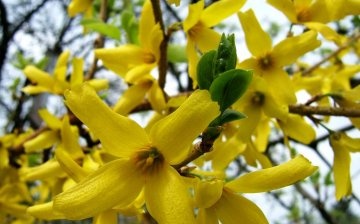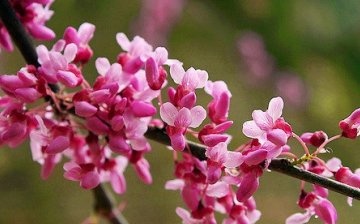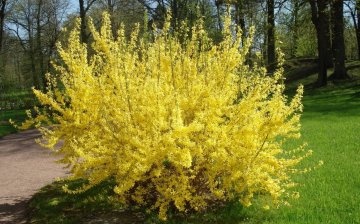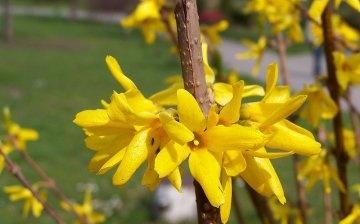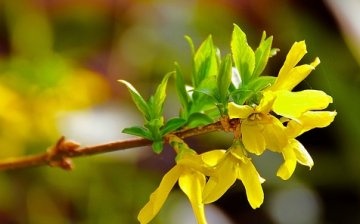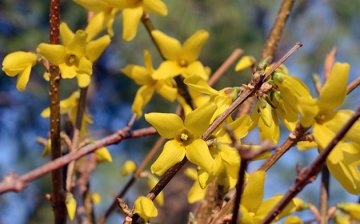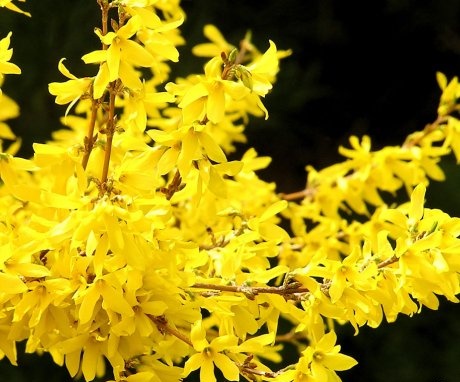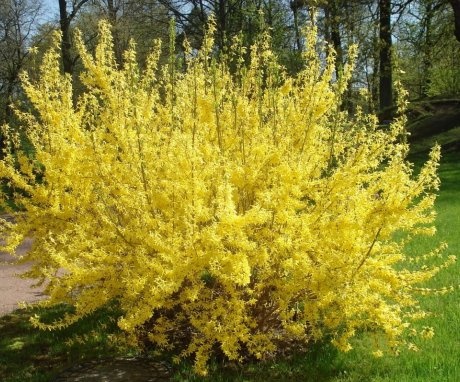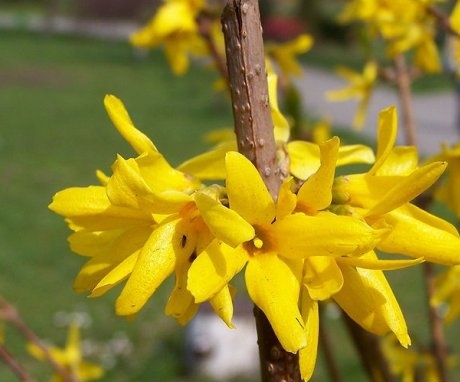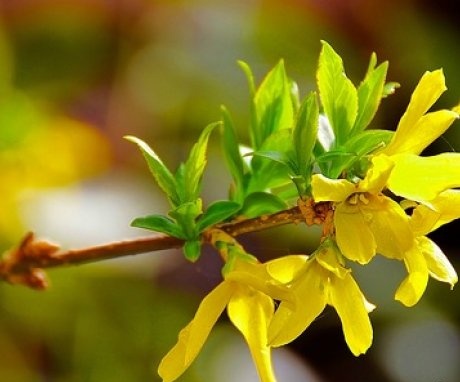Forsythia care: from planting to shelter for the winter
As soon as the weather is warm outside, the bush forsythia covered with solid golden lace. Blooms in March and continues through April. For a month, yellow-golden flowers, somewhat similar to bells, flaunt on flexible and leafless shoots.
Forsythia is loved because of its unpretentious care, long and bright flowering, because the garden is just waking up from winter sleep, and forsythia is already shrouded in a fluffy cloud of flowers.
Content:
- Shrub description
- Popular species and varieties
- Growing conditions
- Proper care and reproduction
- Winter preparation
- Diseases and pests
Shrub description
Forsythia belongs to the Olive family. Representatives of this species bloom earlier than other plants and delight the eye with bright yellow flowers. The height of the bush, depending on the variety, reaches from 1 to 3 meters. The gray-brown bark of a small tree has a rough texture. Oval, simple or trifoliate leaves, serrated at the edges, reach a length of 15 cm.
Forsythia flowers are bright golden, similar to bells.
After flowering, a box appears. "Winged" the seeds forsythia is picked up by the wind and carried to another place. Thus, in natural conditions, self-seeding can occur.
The first forsythia bush was introduced by William Forsyth. A Scottish botanist in the 18th century carefully brought the bush from China to Europe.
Popular species and varieties
The most popular types of shrubs:
- Forsythia European - low bush, the stems of which do not exceed 2 m in height. On upright branches, oblong leaves with solid edges are located. During flowering, it is covered with a cloud of single golden flowers.
- Forsythia Drooping or Hanging is a tall shrub with shoots up to 3 m long and a spreading crown. The brown tetrahedral branches have an olive tint. Abundant flowering, large golden flowers are collected in 2-3 pieces in a bunch.
- Forsythia Giralda is a gentler species that is sensitive to changes in weather conditions. Graceful light flowers appear in May and flowering lasts 3 weeks. Twisted flower petals give a special charm to the plant, creating the image of such a "glamorous" young lady.
- Forsythia Intermediate - obtained by crossing 2 types of plants: dark green and hanging. Differs in tallness, fast growth of shoots. Flowering occurs 4 years after planting. Double or triple leaves have small denticles along the edge, reaching 10 cm in length. Flowering begins in April. The foliage has a rich green color that does not lose its hue throughout the growing season. The species is resistant to winter frosts, easily tolerates temperature fluctuations and mild drought. Feels great on various soils.
Intermediate forsythia varieties:
- Denziflora. An adult shrub looks like a large ball. The plant develops equally well both in height and in width. The branches of the shrub grow up to 1.5 m in length, the diameter of the bush itself can be exactly the same size. It blooms with pale yellow flowers with twisted petals. Flowering lasts 3 weeks.The variety is very delicate, if you do not take care of shelter for the winter, the root system can freeze out during the cold season.
- "Beatrix Farrand" is a tall shrub reaching 4 meters in height. It is famous for its bright flowers. On each petal, at the very base, there are darkening and stripes of a darker color.
- "Spectabilis" is a low bush, reaching only 1 m in height. The diameter of the crown can be 1m 20 cm. Light green foliage is replaced by purple by autumn. Gardeners are attracted to this shift, as it seems that there are 2 different plants growing on the site. Large yellow flowers cover the shoots in April.
Conditions for growing forsythia
Forsythia decorates squares, city streets, suburban areas. The flowering of the plant symbolizes the arrival of spring. Early flowering distinguishes forsythia from other plants.
Growing features shrub:
- Light-loving plants, but can also be grown in partial shade.
- Before planting, it is required to calcify the soil.
- If you plant forsythia against the background of dark needles of plants, you can create a unique composition.
Spring is a good time to plant forsythia. You can transplant the bush to a new place in the fall. But it is important to take into account the time so that the plant can adapt to the new conditions of detention, before winter comes. The place is chosen bright, sunny, protected from cold winter winds, which have a detrimental effect on the shrubs.
The soil must be fertile. If the soil is heavy, poor air permeability is observed, it is required to add rotted manure, river sand and peat. Lime or wood ash should be added to acidic soil.
For planting shrubs, dig holes measuring 50 cm x 50 cm x 60 cm.
If you need to plant several bushes, the distance between them should not be less than 1.5 meters. The bottom of the pit is filled with a drainage layer, then filled with sand to a height of 10 cm. Next comes the soil mixture, which includes peat, sand and leaf earth in a ratio of 1: 1: 2. It is advisable to add wood ash when preparing nutrient soil.
Prepared seedlings dipped into the holes, sprinkled with earth and the soil, which is near the branches, is well compacted. The planted bushes need to be watered well.
Proper care and reproduction
Care for a bush is practically no different from caring for another plant. Forsythia requires timely watering, fertilization to ensure abundant flowering and good growth, rejuvenating and shaping pruning and a shelter for the winter.
The best ways to get new forsythia specimens are cuttings and propagation by layers.
In view of poor germination seed, seed reproduction is not practiced even by experienced gardeners. If you still want to try this method, you need to know that the seeds must pass the mandatory stratification within 2-3 months.
Shrub cuttings:
- For cuttings take spring or summer shoots and make an oblique cut.
- On a 15 cm long cut handle, cut off all the lower foliage.
- Forsythia cuttings are planted in prepared holes in the ground filled with fertile soil at a slight slope.
- Constant monitoring of soil moisture is required. The earthen coma should not be allowed to dry out, as the stalk will die.
- In order for young plants to successfully overwinter, the cuttings need to be covered with spruce legs.
- Only a miracle can help ensure that all planted cuttings take root, usually only 3-4 cuttings take root, in other words, 70% of all planting material.
To propagate by layering, you need to choose a well-developed shoot, tilt it to the ground, slightly incise the bark and attach it to the soil exactly where the cut was made. From above it is required to pour a mound of soil. Thus, rooting will take place much faster, but do not forget about timely watering.
Forsythias grown in a way cuttings and layering, delight with their flowering already 3 years after planting. If you wait for the flowering of forsythia grown by the seed method, then this moment will come only in the 5th year.
Watering:
- Forsythia does not tolerate waterlogged soil.
- When growing a shrub, the main rule is: "it is better not to top up than to pour."
- A temporary lack of moisture will not affect the development of the plant in any way.
- Waterlogged soil leads to the development of putrefactive diseases, the plant eventually dies.
- Watering is needed in dry summers.
- The lack of moisture affects the appearance of the plant: the tops begin to droop, dry out slightly, and the branches lean to the ground. But the turgor of the plant is restored immediately after watering.
In the springtime, forsythia bushes will need organic fertilizers... It responds well to feeding with rotted manure. It can be laid out near the plant, sprinkled with earth and watered abundantly. This fertilizer not only serves as a top dressing for the shrub, but also as a kind of mulch that inhibits the growth of weeds and provides oxygen to the roots of the plant.
Integrated mineral fertilizers are fed 1 time per season at the rate of 70 grams of funds per 1 m2.
Formative and rejuvenating are preferred for the plant. trimming... In early spring, gardeners remove all branches frozen over the winter, as well as damaged pests, shorten the faded branches by 1/3. It is necessary to look at the thickening. If there are a lot of branches, this does not allow the plant to develop normally, and they become more susceptible to diseases and pests. Therefore, the density of the crown should be thinned out.
Winter preparation
To increase resistance to winter frosts, at the end of summer, forsythia should be fed with potash fertilizers containing phosphorus. At the end of summer it is required mulch: Spread a layer of soil with sawdust to a height of 10 cm near the trunk. TO
the ustics are covered with spruce legs for the winter.
Do not use an airtight material such as plastic wrap. The fact is that at above-zero temperatures during thaws, flower buds can dry out and there will be no flowering this year.
Diseases and pests
An unpretentious plant is almost never exposed to diseases and invasion pests... But gardeners faced diseases such as moniliosis, fusarium wilt, and bacteriosis. To combat fusarium, a 2% solution of foundation is used. It is pointless to fight bacteriosis, you can immediately throw out the entire plant so that the disease does not spread to other plantings.
The roots of the plant are attacked by nematodes, these are the most harmful of the parasites.
It is quite difficult to fight the whitish worms. They multiply rapidly, attack delicate roots and suck the juice out of them. The plant weakens and dies over time. Worms don't like smell calendula and marigolds, therefore, these tart plants can be planted next to the forsythia, or even better, when the marigolds and marigolds bloom, pluck the inflorescences and bury them in the ground next to the root system shrub.
Forsythia is a cute and unpretentious shrub. When favorable conditions are created, the plant will delight with abundant flowering for many years. How nice it is to go outside and admire the golden scattering of forsythia flowers, while all the plants are just beginning to wake up from their winter sleep.
More information can be found in the video.



